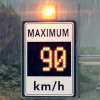 The choice of a safe travel speed depending on the driving environment can be as varied as the number of drivers on the highway. I can recall responding to an injury crash on a icy divided highway where both the ambulance and I were using the left lane and all emergency warning equipment. Even with the urgency of the situation, travelling at 95 in the posted 110 km/h zone seemed to be appropriate to both of us. This was clearly not the case for other drivers as we were passed a number of times by vehicles using the right hand lane.
The choice of a safe travel speed depending on the driving environment can be as varied as the number of drivers on the highway. I can recall responding to an injury crash on a icy divided highway where both the ambulance and I were using the left lane and all emergency warning equipment. Even with the urgency of the situation, travelling at 95 in the posted 110 km/h zone seemed to be appropriate to both of us. This was clearly not the case for other drivers as we were passed a number of times by vehicles using the right hand lane.
2016 will see the first introduction of variable speed limits (VSL) on highways in British Columbia. Slated for implementation segments of the Sea to Sky, Coquihalla and Trans Canada highways, the speed limit will be shown on electronic speed signs that can be changed remotely based on existing weather conditions. Data for the changes will be gathered through pavement and visibility sensors installed in these highway segments. Operations staff with the Ministry of Transportation and Infrastructure will use the data to change the speed limit displayed to one that is appropriate for safety.
Experience with VSL elsewhere indicates that it is generally well received by drivers and results in a safety improvement. VSL are especially effective if variable message signs indicate why the change has occurred. One drawback appears to be a tendency to create greater speed variance between vehicles. Another issue is that to remain effective, speed enforcement needs to be sufficient to maintain compliance.
Perhaps highway segments with VSL would be an ideal opportunity to introduce time over distance automated speed enforcement as well. The danger presented by conventional enforcement methods increases as VSL decrease. Automated enforcement could increase compliance and maintain uniformity in application without increasing risk.
Learn More
- Variable Speed Limit Corridors in British Columbia
- Driver Behavior Evaluation of Variable Speed Limits
- Variable Speed Limit System on I-80 in Southeastern Wyoming
Share This Article
Perhaps highway segments with VSL would be an ideal opportunity to introduce time over distance automated speed enforcement as well.
But as the speed limit would vary according to conditions, it might be difficult to ensure it held up in court.
What I think we need, in terms of automated enforcement, is a sequence of cameras, three or four would be needed, to check the time gap between vehicles. That way, if it could be shown that a driver was consistently too close to the vehicle ahead (say, within less than a second - and it wouldn't matter how fast they were going) the vehicle owner would be issued a ticket.
Tailgating - that is, following too close - is the commonest reason behind the most frequent crash; the 2- car collision.
If some bozo wants to drive more quickly than is safe, and nobody else is affected when they lose control, that's their problem. But if they're behind me, then they're putting my health at risk. And no, I don't ever block the left lane.
- Log in to post comments
I see the idea of variable speed signs as somewhat redundant. Police can already issue a ticket for driving too fast for prevailing conditions, which covers appropriate speed in poor road conditions. The issue I have with variable speed limits is the accuracy of the data upon which they are based. The current electronic road advisory signs often provide out of date information. They frequently warn of compact snow or slushy conditions, however when I traverse the affected section of road I often find it bare and clear. To have the police, or an automated photo radar system enforcing a variable speed limit based upon inaccurate data would be pointless and counterproductive to the cause of safety. The ministry of transportation will have to vastly improve it's road and weather information systems if such a system is going to be seen as effective and accepted by the motoring public.
- Log in to post comments
- Log in to post comments

Perhaps